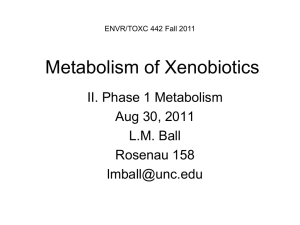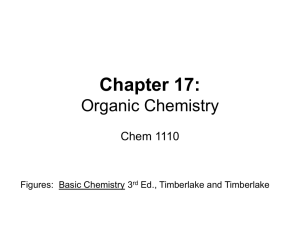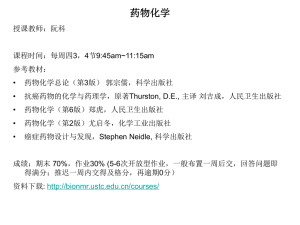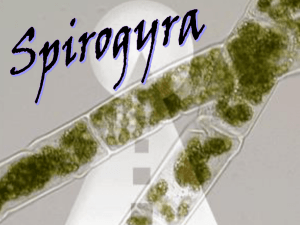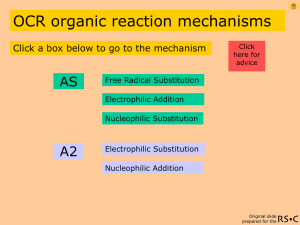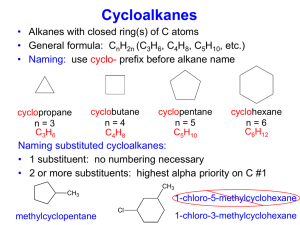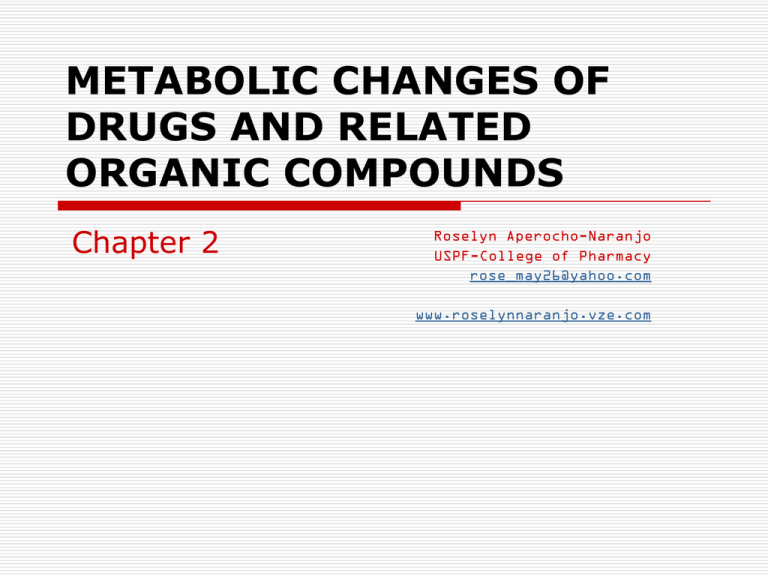
METABOLIC CHANGES OF
DRUGS AND RELATED
ORGANIC COMPOUNDS
Chapter 2
Roselyn Aperocho-Naranjo
USPF-College of Pharmacy
rose_may26@yahoo.com
www.roselynnaranjo.vze.com
METABOLISM
> chemical reaction that occur in the body to maintain
life
> allow organisms to grow and reproduce, maintain their
structures, and respond to their environments
> divided into two categories:
* Catabolism breaks down organic matter
*Anabolism uses energy to build up or construct
components of cells such as proteins and
nucleic acids.
Background
Drug molecules easily
diffuse through
membranes
Reach the
target site &
produce a
pharmacologic
response
Most drugs that
enter the body
are lipid-soluble
Metabolized in the liver
Background
Of Drugs or Xenobiotics
Metabolism
plays a central
role in the
Elimination
Sites of Drug
Biotransformation
2. Liver (hepatic metabolism
or First Pass Effect
The most important organ in
drug metabolism
Some drugs may decrease
Oral bioavailability
Lidocaine (ineffective)
Isoproterenol
Meperidine
Morphine
Nitroglycerin
Pentazocaine
Propoxyphene
Propranolol
salicylamide
1. Gastrointestinal Tract
Absorb orally administered drugs
3. Blood Circulation
Absorb orally administered drugs
General Pathways of Drug
Metabolism
> Phase I or Functionalization
Reactions includes:
* Oxidative Reaction
* Reductive Reaction
* Hydrolytic Biotransformation
General Pathways of Drug
Metabolism
Phase II or Conjugation Reaction
* Glucoronic Acid Conjugation
* Sulfate Conjugation
* Conjugation with Glycine, Glutamine and
other Amino Acids
* Glutathione or Mercapturic Acid Conjugation
* Acetylation
* Methylation
General Summary of Phase I and
Phase II Metabolic Pathways
PHASE I or FUNCTIONALIZATION REACTIONS
A. Oxidation Reactions
-Oxidation of Aromatic Moieties
-Oxidation of Olefins
-Oxidation of Benzyclic, Allylic carbon atoms, carbon
atoms ∂ Carbon atoms to carbonyl and imines
-Oxidation of Aliphatic and Alicyclic carbon atoms
-Oxidation of Carbon-heteroatom systems:
* Caron-Nitrogen system
* Carbon – Sulfur system
* Caron – Oxygen system
-Carbon – Alcohols and Aldehydes
-Other miscellaneous oxidative reactions
B. Reductive Reactions
- Reduction of aldehydes and ketones
- Reduction of Nitro and Azo compounds
- Miscellaneous Reductive reactions
C. Hydrolytic Reactions
- Hydrolysis of Esters and Amides
- Hydration of Epoxides and arene oxide by
epoxide hydrase
PHASE II or CONJUGSTION REACTIONS
A. Glucuronic Acid Conjugation
B. Sulfate Conjugation
C. Conjugation with Glycine, Glutamine and other Amino Acids
D. Glutathione or Mercapturic Acid Conjugation
E. Acetylation
D. Methylation
General Summary of Phase I and
Phase II Metabolic Pathways
PHASE I or FUNCTIONALIZATION REACTIONS
A. Oxidation Reactions
-Oxidation of Aromatic Moieties
-Oxidation of Olefins
-Oxidation of Benzyclic, Allylic carbon atoms, carbon
atoms ∂ Carbon atoms to carbonyl and imines
-Oxidation of Aliphatic and Alicyclic carbon atoms
-Oxidation of Carbon-heteroatom systems:
* Caron-Nitrogen system
* Carbon – Sulfur system
* Caron – Oxygen system
-Carbon – Alcohols and Aldehydes
-Other miscellaneous oxidative reactions
B. Reductive Reactions
- Reduction of aldehydes and ketones
- Reduction of Nitro and Azo compounds
- Miscellaneous Reductive reactions
C. Hydrolytic Reactions
- Hydrolysis of Esters and Amides
- Hydration of Epoxides and arene oxide by
epoxide hydrase
PHASE II or CONJUGSTION REACTIONS
A. Glucuronic Acid Conjugation
B. Sulfate Conjugation
C. Conjugation with Glycine, Glutamine and other Amino Acids
D. Glutathione or Mercapturic Acid Conjugation
E. Acetylation
D. Methylation
OXIDATIVE REACTIONS
Oxidation of Aromatic moieties
-refers to the mixed-function oxidation of aromatic compounds
(arenes) to their corresponding phenolic metabolites (arenols).
R
I
Arene
R
I
Arene oxide
R
I
O
OH
Arenol
Arene Oxides
A. Spontaneous arrangement
R
I
R
I
I
O
Arene oxide
R
I
H
O
H
I
OH
Arenols
Example of Oxidation Reaction
Allylic Hydroxylation of Marijuana
(Δ1 tetra Hydrocannabinol)
CH3
CH3
CH3
CH2OH
CH3
CH3
Example of Oxidation Reaction
Allylic Hydroxylation of Marijuana
(Δ1 tetra Hydrocannabinol)
(CH3)
H
H-C-H
I
H
H-C-OH
H
(CH2OH)
Example of Oxidation Reaction
1. Allylic Hydroxylation of Marijuana
(Δ1 tetra Hydrocannabinol)
CH3
CH3
CH3
CH2OH
CH3
CH3
7- Hydroxy Δ1 tetra Hydrocannabinol
Example of Oxidation Reaction
2. Oxidation of THC to Carboxylic Acid derivative
CH2OH
CH3
CH3
7- Hydroxy Δ1 tetra
Hydrocannabinol
COOH
CH3
CH3
7- Δ1 tetra
Hydrocannabinoic
Acid
Example of Oxidation Reaction
3. Oxidation of THC to Carboxylic Acid derivative and Conjugation
with Glucuronic Acid
COOR
CH3
CH3
Glucuronide conjugate
O
ll
C-O-
R–
alkyl group
Oxidation Reaction
Oxidation of Benzyclic Carbon Atoms
- the primary alcohol are often oxidized to form aldehydes
and carboxyllic acids
CH2OH –------ CHO ------------- COOH
CH2OH
CH3
CH3
7- Hydroxy Δ1 tetra
Hydrocannabinol
CHO
CH3
CH3
COOH
CH3
CH3
Oxidation Reaction
Oxidation of C atoms ∂ to Carbonyl’s &
Imines
- is a mixed function oxidase system which involve C
atoms adjacent to carbonyl and imino (C=N) group.
N-demethylation
diazepam
H
H
H
OH
OH
3-hydroxydiazepam
oxazepam
Oxidation Reaction
Oxidation at aliphatic and alicyclic C
atoms
- aliphatic hydroxylation commonly take place in drug
molecules with straight or branched alkyl chains.
Drugs that undergo Aliphatic Oxidation are the following:
Valproic Acid (Depakene) – antiepileptic agent
Barbiturates (Phenobarbital and Secorbarbital)
Oral hypoglycemic (Diabenese)
Sulfonylurea
Anti-inflammatory agent (Motrin)
Meprobamate
Glutethimide
Ethosuximide
Phenylbutazone
Important Therapeutic Agents that
undergo Aromatic Hydroxylation
Propranolol
Phenobarbital
back
Important Therapeutic Agents that
undergo Aromatic Hydroxylation
Phenytoin
Phenylbutazone
Important Therapeutic Agents that
undergo Aromatic Hydroxylation
Ethinylestradiol
Warfarin
Important Therapeutic Agents that
undergo Aromatic Hydroxylation
Amphetamine
Important Therapeutic Agents that
undergo Aromatic Hydroxylation
Deactivating groups generally slow or
resist aromatic hydroxylation
includes:
Chloro (Cl)
Amino group(NR3)
COOH
SO2
NH-R
Role of Cytochrome P-450
Monooxygenases in Oxidative
Biotransformation
General Equation describing the oxidation of many
xenobiotics (R-H) forming a metabolite (R-OH)
R-H + NADPH + O2 + H+
substrate
Reducing
agent
R-OH + NADPH + H2 O
Molecular
O2
Mixed Function in the biotransformation with Monooxygenases
Requires both molecular and a reducing agent
Enzyme responsible for transferring an Oxygen atom to the substrate
is called Cytochrome P-450
What is Cytochrome P-450
structure
Important features:
-Plays a vital role in oxidation of
lipophilic xenobiotics
-metabolize almost unlimited number
of diverse substrates by a variety of
oxidative transformations.
-located in the endoplasmic reticulum
…to be continued next
meeting. Please
prepare ½ crosswise
for a short quiz…
Good Luck!
General Pathways of Drug
Metabolism
Phase II or Conjugation Reaction
* Glucoronic Acid Conjugation
* Sulfate Conjugation
* Conjugation with Glycine, Glutamine and
other Amino Acids
* Glutathione or Mercapturic Acid Conjugation
* Acetylation
* Methylation
Factors Affecting Dug Metabolism
Age Difference
Species and Strain Differences
Hereditary or Genetic Factors
Sex Differences
Enzyme Induction
Enzyme Inhibition
Metabolism
Pharmacologically active Metabolites
A. Age
Undeveloped or deficient oxidative and conjugative
enzyme causes a reduced metabolic capability of
newborns.
Metabolic reacion increases after after birth or when
approaches adult levels
Influence of age on drug metabolism is seen on the
duration of action of the drug (sleep time) in nweborn
and adults.
Example: newborn mice sleeps 6 hours
adult sleeps fewer than 6 minutes if given the
same dose of 10mg/kg of body weight
In Humans – half life of tolbutamide is 8 hours while in
infants it is 40 hours.
B. Species 7 Strain Differences


